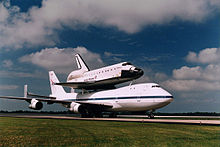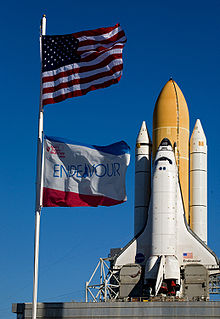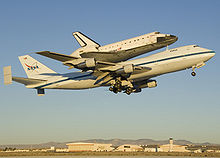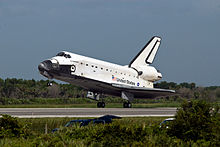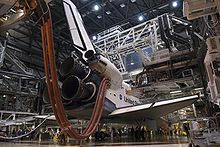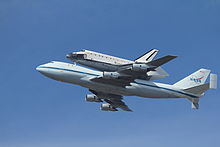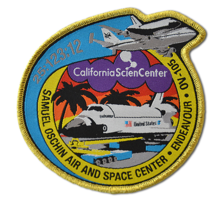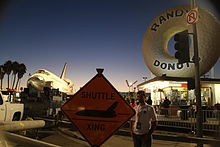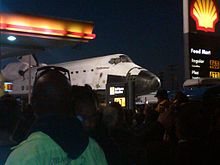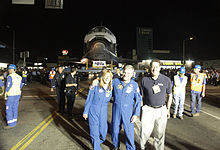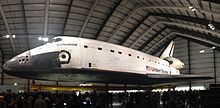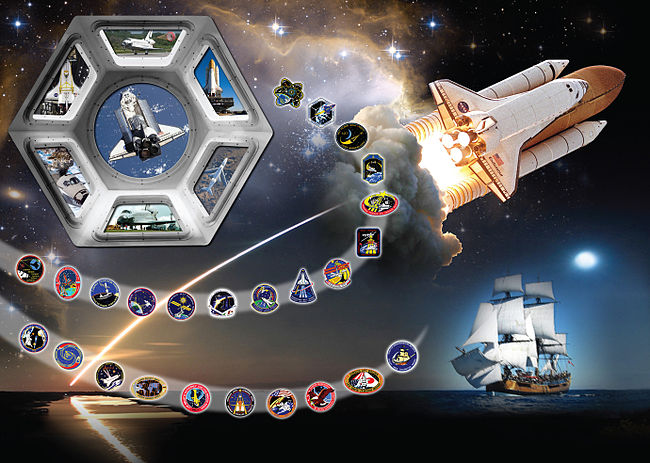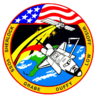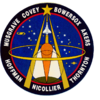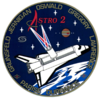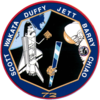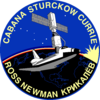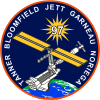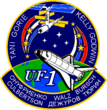
Space Shuttle Endeavour
Background Information
SOS Children, an education charity, organised this selection. Visit the SOS Children website at http://www.soschildren.org/
| Endeavour OV-105 |
|
|---|---|
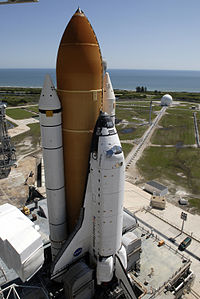 Space Shuttle Endeavour on launch pad 39A prior to mission STS-127, May 31, 2009 |
|
| OV designation | OV-105 |
| Country | United States |
| Contract award | July 31, 1987 |
| Named after | HMS Endeavour (1764) |
| Status | Retired, displayed at California Science Centre in Los Angeles, California |
| First flight | STS-49 May 7, 1992 – May 16, 1992 |
| Last flight |
Ferry flight on SCA NASA905 to Los Angeles, California September 19–21, 2012 |
| Number of missions | 25 |
| Crew members | 154 |
| Time spent in space | 296 days, 3 hours, 34 minutes, 2 seconds |
| Number of orbits | 4,671 |
| Distance travelled | 122,883,151 mi (197,761,262 km) |
| Satellites deployed | 3 |
| Mir dockings | 1 |
| ISS dockings | 12 |
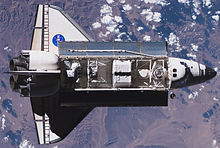
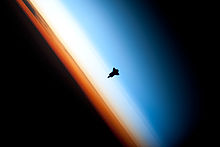
Space Shuttle Endeavour ( Orbiter Vehicle Designation: OV-105) is one of the retired orbiters of the Space Shuttle program of NASA, the space agency of the United States. Endeavour was the fifth and final spaceworthy NASA space shuttle to be built, and first flew in May 1992 on mission STS-49 and its last mission STS-134 was in May 2011. The STS-134 mission was originally planned as the final mission of the Space Shuttle program, but with authorization of the STS-135 mission, Atlantis became the last Space Shuttle to fly.
The United States Congress authorized the construction of Endeavour in 1987 to replace Challenger, which was lost in the STS-51-L launch accident in 1986. Structural spares built during the construction of Discovery and Atlantis, two of the previous shuttles, were used in its assembly. NASA chose to build Endeavour from spares rather than refitting Enterprise or accepting a Rockwell International proposal to build two shuttles for the price of one of the original shuttles, on cost grounds.
History
The orbiter is named after the British HMS Endeavour, the ship which took Captain James Cook on his first voyage of discovery (1768–1771). This is why the name is spelled in the British English manner, rather than the American English ("Endeavor"). This has caused confusion, most notably when NASA itself misspelled a sign on the launch pad in 2007. The name also honored Endeavour, the Command Module of Apollo 15, itself also named after Cook's ship.
Endeavour was named through a national competition involving students in elementary and secondary schools. Entries included an essay about the name, the story behind it and why it was appropriate for a NASA shuttle, and the project that supported the name. Endeavour was the most popular entry, accounting for almost one-third of the state-level winners. The national winners were Senatobia Middle School in Senatobia, Mississippi, in the elementary division and Tallulah Falls School in Tallulah Falls, Georgia, in the upper school division. They were honored at several ceremonies in Washington, D.C., including a White House ceremony where then-President George H. W. Bush presented awards to each school.
Service
Endeavour was delivered by Rockwell International Space Transportation Systems Division in May 1991 and first launched a year later, in May 1992, on STS-49. Rockwell International claimed that it had made no profit on Space Shuttle Endeavour, despite construction costing US$2.2 billion. On its first mission, it captured and redeployed the stranded INTELSAT VI communications satellite. The first African-American woman astronaut, Mae Jemison, was brought into space on the mission STS-47 on September 12, 1992.
In 1993, it made the first service mission to the Hubble Space Telescope. Endeavour was withdrawn from service for eight months in 1997 for a retrofit, including installation of a new airlock. In December 1998, it delivered the Unity Module to the Zarya module of the International Space Station.
Endeavour's last Orbiter Major Modification period began in December 2003 and ended on October 6, 2005. During this time, the Orbiter Vehicle-105 received major hardware upgrades, including a new, multi-functional, electronic display system, often referred to as a glass cockpit, and an advanced GPS receiver, along with safety upgrades recommended by the Columbia Accident Investigation Board (CAIB) for the shuttle to return to flight after the disintegration of sister-ship Columbia during re-entry on February 1, 2003.
The STS-118 mission, the first for Endeavour following a lengthy refit, included astronaut Barbara Morgan, formerly assigned to the Educator Astronaut program, but now a full member of the Astronaut Corps, as part of the crew. Morgan was the backup for Christa McAuliffe on the ill-fated STS-51-L mission.
Early milestones
| Date | Milestone |
|---|---|
| 1982 February 15 | Start structural assembly of crew module (built as structural spare alongside Discovery and Atlantis) |
| 1987 July 31 | Contract award to Rockwell International |
| 1987 August 1 | Start of Final Assembly |
| 1987 September 28 | Start structural assembly of aft fuselage |
| 1990 July 6 | Completed Final Assembly |
| 1991 April 25 | Rollout from Palmdale |
| 1991 May 7 | Delivery to Kennedy Space Centre |
| 1992 April 6 | Flight Readiness Firing (FRF) |
| 1992 May 7 | First flight ( STS-49) |
Upgrades and features
As it was constructed later, Endeavour was built with new hardware designed to improve and expand orbiter capabilities. Most of this equipment was later incorporated into the other three orbiters during out-of-service major inspection and modification programs. Endeavour’s upgrades include:
- A 40-foot (12 m) diameter drag chute that reduced the orbiter's rollout distance by 1,000 to 2,000 feet (300 to 610 m).
- The plumbing and electrical connections needed for Extended Duration Orbiter (EDO) modifications to allow up to a 28-day mission (although a 28-day mission was never attempted; the record is 17 days, which was set by Columbia).
- Updated avionics systems that included advanced general purpose computers, improved inertial measurement units and tactical air navigation systems, enhanced master events controllers and multiplexer-demultiplexers, a solid-state star tracker and improved nose wheel steering mechanisms.
- An improved version of the Auxiliary Power Units (APUs) that provided power to operate the Shuttle's hydraulic systems.
Modifications resulting from a 2005–2006 refit of Endeavour include:
- The Station-to-Shuttle Power Transfer System (SSPTS), which converted 8 kilowatts of DC power from the ISS main voltage of 120VDC to the orbiter bus voltage of 28VDC. This upgrade allowed Endeavour to remain on-orbit while docked at ISS for an additional 3- to 4-day duration. The corresponding power equipment was added to the ISS during the STS-116 station assembly mission, and Endeavour flew with SSPTS capability during STS-118.
Final flights
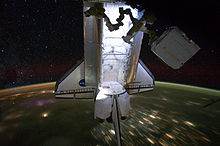
Endeavour flew its final mission, STS-134, to the International Space Station (ISS) in May 2011. After the conclusion of STS-134, Endeavour was formally decommissioned.
Endeavour was originally scheduled to be decommissioned in 2010 after 18 years of service, but on July 1, 2010, NASA released a statement saying the Endeavour mission was rescheduled for February 27, 2011, instead of late November, 2010.
"The target dates were adjusted because critical payload hardware for STS-133 will not be ready in time to support the previously planned 16 September launch," NASA said in a statement. With the Discovery launch moving to November, Endeavour mission "cannot fly as planned, so the next available launch window is in February 2011," NASA said, adding that the launch dates are subject to change.
The launch was once again postponed until April 29, 2011, in order to avoid a scheduling conflict with a Russian supply vehicle heading for the International Space Station.
The launch was finally carried out on May 16, 2011. Shuttle Endeavour's last mission, STS-134, was a successful launch at 08:56 EST.
Endeavour completed its final mission with a landing at the Kennedy Space Centre at 06:34 UTC on June 1, 2011. Over its flight career, Endeavour flew 122,853,151 miles and spent 299 days in space. While flying Endeavour's last mission, the Russian spacecraft Soyuz TMA-20 departed from the ISS and paused at a distance of 200 meters. Italian astronaut Paolo Nespoli took a series of photographs and videos of the ISS with Endeavour docked. This was the second time a Shuttle had been photographed while docked and the first time since 1996. Commander Mark Kelly was the last astronaut off Endeavour after the landing, and the crew stayed on the landing strip long enough to sign autographs and pose for pictures. With commander Mark Kelly and pilot Gregory Johnson at the controls, Endeavour's touchdown was the 25th time a shuttle performed a night landing.
One final mission, STS-135, was added to the schedule in January 2011, and Atlantis flew for the last time in July 2011.
Decommissioning
After more than twenty organizations submitted proposals to NASA for the display of an orbiter, NASA announced that Endeavour will go to the California Science Centre in Los Angeles.
After low level flyovers above NASA and civic landmarks across the country and in California, it was delivered to Los Angeles International Airport (LAX) on September 21, 2012. The orbiter was slowly and carefully transported through the streets of Los Angeles and Inglewood three weeks later, from October 11-14 along La Tijera, Manchester, Crenshaw, and Martin Luther King, Jr. Boulevards to her final destination at the California Science Centre in Exposition Park.
Endeavour encountered a few obstacles while transiting the streets narrowly missing telephone poles, apartment buildings and other structures. The power had to be turned off and power carrying poles had to be removed temporarily as the orbiter crept along Manchester to Prairie Avenue then Crenshaw Boulevard. News crews lined the streets along the path with visible news personalities in the news trucks. There were several police escorts as well as considerable security helping to control the large crowds gathered. Endeavour was parked for a few hours at the Great Western Forum where it was available for viewing. Taking longer than expected, Endeavour finally reached the Science Centre on October 14.
The exhibit was opened to the public on October 30, 2012 at the temporary Samuel Oschin Space Shuttle Endeavour Display Pavilion of the museum. A new addition to the Science Centre, called the Samuel Oschin Air and Space Centre, is under construction as Endeavour's permanent home. Planned for a 2017 opening, the Endeavour will be mounted vertically with an external tank and a pair of solid rocket boosters in the shuttle stack configuration. One payload door will be open to reveal a demonstration payload inside.
After its decommissioning, Endeavour's Canadarm (formally the 'Shuttle Remote Manipulator System') was removed in order to be sent to the Canadian Space Agency’s John H. Chapman Space Centre in Longueuil, Quebec, a suburb of Montreal, where it will be placed on display. The Space Agency's Longueuil headquarters was an unlikely choice for the display of the Canadian-built robotic device. In a Canadian poll on which science or aerospace museum should be selected to display the Canadarm, originally built by SPAR Aerospace, the Canadian Space Agency’s headquarters placed third to last with only 35 out of 638 votes.
Flights
| # | Launch date | Designation | Launch pad | Landing location | Notes |
|---|---|---|---|---|---|
| 1 | 1992-05-07 | STS-49 | 39-B | Edwards Air Force Base | First flight of Endeavour: Capture and redeploy Intelsat VI. First three-man EVA, longest US EVA since Apollo 17. |
| 2 | 1992-09-12 | STS-47 | 39-B | Kennedy Space Centre | Spacelab mission J with the first African American woman in space, Mae Jemison |
| 3 | 1993-01-13 | STS-54 | 39-B | Kennedy | Deploy TDRS-F |
| 4 | 1993-06-21 | STS-57 | 39-B | Kennedy | Spacelab experiments. Retrieve European Retrievable Carrier |
| 5 | 1993-12-02 | STS-61 | 39-B | Kennedy | First Hubble Space Telescope service mission (HSM-1) |
| 6 | 1994-04-09 | STS-59 | 39-A | Edwards | Space Radar Laboratory experiments |
| 7 | 1994-09-30 | STS-68 | 39-A | Edwards | Space Radar Laboratory experiments |
| 8 | 1995-03-02 | STS-67 | 39-A | Edwards | Spacelab Astro-2 experiments‡ |
| 9 | 1995-09-07 | STS-69 | 39-A | Kennedy | Wake Shield Facility and other experiments |
| 10 | 1996-01-11 | STS-72 | 39-B | Kennedy | Retrieve Japanese Space Flyer Unit |
| 11 | 1996-05-19 | STS-77 | 39-B | Kennedy | Spacelab experiments |
| 12 | 1998-01-22 | STS-89 | 39-A | Kennedy | Rendezvous with Mir space station and astronaut exchange |
| 13 | 1998-12-04 | STS-88 | 39-A | Kennedy | International Space Station assembly mission 2A (assembled the Unity Module (Node 1), first American component of the ISS) |
| 14 | 2000-02-11 | STS-99 | 39-A | Kennedy | Shuttle Radar Topography Mission experiments |
| 15 | 2000-11-30 | STS-97 | 39-B | Kennedy | International Space Station assembly mission ( P6 truss segment) |
| 16 | 2001-04-19 | STS-100 | 39-A | Edwards | International Space Station assembly mission 6A ( Canadarm2 robotic arm and hand) |
| 17 | 2001-12-05 | STS-108 | 39-B | Kennedy | International Space Station assembly mission UF-1, rendezvous and astronaut exchange ( Expedition 3/ Expedition 4) |
| 18 | 2002-06-05 | STS-111 | 39-A | Edwards | International Space Station assembly mission UF-2, rendezvous and astronaut exchange ( Expedition 4/ Expedition 5) |
| 19 | 2002-11-23 | STS-113 | 39-A | Kennedy | International Space Station assembly mission 11A and astronaut exchange/final successful shuttle flight before the Columbia disaster ( Expedition 5/ 6 exchange; P1 truss segment assembly) |
| 20 | 2007-08-08 | STS-118 | 39-A | Kennedy | Four spacewalks conducted. Installation of the International Space Station S5 Truss, of the Integrated Truss Structure. Carried a SPACEHAB module carrying 5,000 pounds of supplies and equipment to the International Space Station. Crew included the Educator Astronaut Barbara Morgan. Thermal tiles protecting the underside of the vehicle were damaged during launch. NASA decided not to fix this damage in-flight as it was not believed to be serious enough to result in loss of vehicle or crew. The craft landed a day early due to the possibility that Hurricane Dean would force Mission Control to evacuate. |
| 21 | 2008-03-11 | STS-123 | 39-A | Kennedy | International Space Station assembly mission 1J/A which delivered the first element of Japan's Kibo module along with the Canadian Special Purpose Dexterous Manipulator robotic arm, and the Spacelab Pallet-Deployable 1. |
| 22 | 2008-11-14 | STS-126 | 39-A | Edwards | International Space Station assembly mission that brought equipment and supplies in the Multi-Purpose Logistics Module Leonardo, and Expedition 18 crew rotation, Sandra Magnus replaced Gregory Chamitoff. Endeavour was the only orbiter to land on the temporary Runway 4 at Edwards AFB, as the refurbished main runway will be operational from STS-119 onwards. |
| 23 | 2009-07-15 | STS-127 | 39-A | Kennedy | International Space Station assembly mission which delivered the last two elements of Japan's Kibo Module along with the Spacelab Pallet-Deployable 2, and an Integrated Cargo Carrier-Vertical Light Deployable. |
| 24 | 2010-02-08 | STS-130 | 39-A | Kennedy | International Space Station assembly mission which delivered the Node 3 and the Cupola observatory to the station. This brought the ISS to 98 percent completion. |
| 25 | 2011-05-16 | STS-134 | 39-A | Kennedy | International Space Station assembly mission which delivered the Alpha Magnetic Spectrometer and the ELC-3 to the space station. This was the final mission of Endeavour. Although originally planned to be the last space shuttle program flight, one additional flight of Atlantis, STS-135, was flown in July 2011. |
‡ Longest shuttle mission for Endeavour
Tribute and mission insignias
| NASA Orbiter Tribute for Space Shuttle Endeavour | |||||||
|---|---|---|---|---|---|---|---|
|
|
|||||||
| Mission insignia for Endeavour mission flights | |||||||
|
|
|
|
|
|
|
|
|
|
|
|
|
|
|
|
|
|
|
|
|
|
|
|
|
|
|
|
|
|
|
|
|
|
|
|
|
|
|
|
|
|
|
|
|
|
|
|
|
|
|
|
|
|
|
|
|||||||
|
|
|||||||
